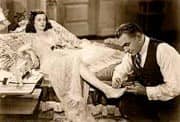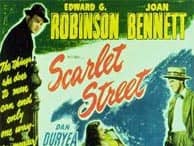"He didn't get away with it, did he? He'll go to the chair, as he should."—Adelle Cross
 A few dates are all it takes to realize that Miss Film Noir, despite her reputation as one of the most beloved and oft-studied genres in cinematic history, is one strange, frighteningly bipolar dame.
A few dates are all it takes to realize that Miss Film Noir, despite her reputation as one of the most beloved and oft-studied genres in cinematic history, is one strange, frighteningly bipolar dame.
 The deadly molls, hard-bitten gumshoes, and rain-drenched streets popularized by Dashiell Hammet, Raymond Chandler, and their compatriots (and brought to glorious cinematic life by directors like Billy Wilder, Otto Preminger, and John Huston) conjure up an era of inelegant theatrics and romanticized cynicism that has become difficult for the modern viewer to stomach. Their stories are yellowing snapshots of a past where improbably sarcastic characters battled for their souls against the backdrop of an eternal, obsolete night.
The deadly molls, hard-bitten gumshoes, and rain-drenched streets popularized by Dashiell Hammet, Raymond Chandler, and their compatriots (and brought to glorious cinematic life by directors like Billy Wilder, Otto Preminger, and John Huston) conjure up an era of inelegant theatrics and romanticized cynicism that has become difficult for the modern viewer to stomach. Their stories are yellowing snapshots of a past where improbably sarcastic characters battled for their souls against the backdrop of an eternal, obsolete night.
Yet despite the over-dark settings, archaic slang, and unlikely stereotypes that populate most noir film, they contain a persistent and morally relevant timelessness. To this day, no genre deals as clearly or as deeply with the never-ending conflict between a man and his temptations, or with the corrosive, devouring effects of sin. And what could possibly be more timely and relevant than that?
Scarlet Street, from legendary director Fritz Lang, is a lesser-known member of the noir family—an odd fact given that it is one of only a handful of films in the public domain—but one well-deserving of our attention for the way it makes use of typical noir characteristics, and then subverts them.
 Edward G. Robinson, a classic-film icon best remembered for his breakout role as Rico in Little Caesar, is Christopher Cross: bland cashier by day; failed painter and hen-pecked husband by night. Fresh off the depressing celebration of his insignificant 25-year career at a clothing retailer in New York City, he happens across a young woman (Joan Bennett) being viciously attacked by a street thug, and rushes to her defense.
Edward G. Robinson, a classic-film icon best remembered for his breakout role as Rico in Little Caesar, is Christopher Cross: bland cashier by day; failed painter and hen-pecked husband by night. Fresh off the depressing celebration of his insignificant 25-year career at a clothing retailer in New York City, he happens across a young woman (Joan Bennett) being viciously attacked by a street thug, and rushes to her defense.
Oblivious to the unmistakable signs of her unsavory occupation, Chris is smitten with the bright young thing—Kitty March is the first ray of life and hope that has fallen on his mundane existence for many years. Reluctant to reveal his lack of accomplishments to his new-found acquaintance, Cross allows her to assume that he is a wealthy, unattached artist. She, in turn, conceals a secret of her own: the violent young man from whom she was rescued is actually her boyfriend, Johnny, who has been schooling her in underhanded dealings since they first met.
Recognizing the potential in Cross' growing infatuation, and goaded on by Johnny's desire for an "easy mark," Kitty ensnares the hapless cashier with a mesmerizing mixture of brashness, beauty, and charm. But Johnny's insistence forces Kitty to speed up her plans of entrapment: Soon, Cross is embezzling his employer's funds, crafting a rift in his already-fragile marriage, and watching Kitty make a fine living posing as the "artist" behind his previously-unknown, but now surprisingly successful paintings.
All this, Cross suffers gladly for the sake of his new-found love, but when Johnny enters the picture and threatens to reveal the shallowness of Kitty's devotions, things take an ugly turn. In a drunken, jealous rage, Cross confronts Kitty, only to learn that she finds him as useless and unappealing as he has always believed himself to be. Stung by her rejection, he lashes out violently, and Kitty pays the ultimate price.
Appalled at his uncharacteristic action, Cross resolves to punish the man he holds responsible for destroying something infinitely more precious than Kitty's life—her innocence. Assisted by a series of strangely fortuitous circumstances, he frames the hapless Johnny for his crime, and escapes unscathed.
Or does he?
The film departs in a number of ways from the well-established noir path, particularly in its main characters. Cross' age and lot in life are much less glamorous than that of most noir protagonists; he is not simply ordinary, he's insignificant. And Kitty is an equally atypical noir woman, lacking much of the mystery and allure that makes her fellow femme fatales so deadly. But the most striking instance of Lang's departure from the genre's traditions is in Scarlet Street's finale.





